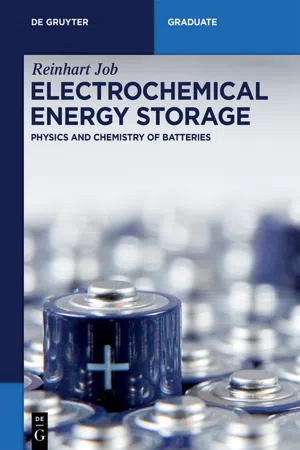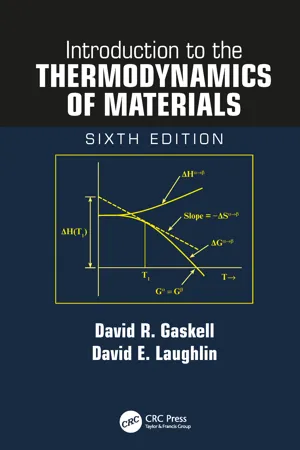Chemistry
Cell Potential
Cell potential, also known as electromotive force, is a measure of the potential difference between the two electrodes of an electrochemical cell. It represents the driving force for the movement of electrons through the cell. Cell potential is a key concept in understanding the behavior of electrochemical cells and is crucial in determining the feasibility and direction of redox reactions.
Written by Perlego with AI-assistance
Related key terms
Related key terms
1 of 4
Related key terms
1 of 3
12 Key excerpts on "Cell Potential"
- eBook - ePub
- C. Vincent, Bruno Scrosati(Authors)
- 1997(Publication Date)
- Butterworth-Heinemann(Publisher)
The emf of a reversible cell can be regarded either as a function of the free energy change associated with the overall cell reaction or as a sum of the Galvani potential differences between phases within the cell. It was noted above, however, that individual Galvani potential differences between non-identical phases could not be measured and it is therefore impossible to resolve a cell emf into its interphasial components. On the other hand, every cell reaction consists of an oxidation and a reduction process and thus can be considered as the sum of two notional ‘half-reactions’ occurring in notional ‘half-cells’. For example, the Daniell cell can be visualized as consisting of the half-cellsC u s | Z n s |andZ n2 +a q,m 1C u s |C u2 +a q,m 2If cells are constructed by making different combinations of half-cells, then the cell emf values obey an additive law. It is therefore convenient to combine half-cells with a single reference half-cell and thus obtain a series of related emf values compared to the reference half-cell taken as zero.The universally accepted primary reference half-cell is the standard hydrogen electrode. The electrode consists of a noble metal (platinized platinum) dipping into a solution of hydrogen ions at unit activity and saturated with hydrogen gas at 1 bar (i.e. 1 × 105 Pa, which in practical terms may be taken to be equal to 1 atmosphere). In practice such a standard electrode cannot be realized, but the scale it defines can.The electrode potential is defined as the potential difference between the terminals of a cell constructed of the half-cell in question and a standard hydrogen electrode (or its equivalent) and assuming that the terminal of the latter is at zero volts. Note therefore that the electrode potential is an observable physical quantity and is unaffected by the conventions used for writing cells. The statement ‘… the electrode potential of zinc is − 0.76 volts …’ implies only that a voltmeter placed across the terminals of a cell consisting of standard hydrogen electrode and the zinc electrode would show this value of potential difference, with the zinc terminal negative with respect to that of the hydrogen electrode. An electrode potential is never - eBook - ePub
- A.P.H. Peters(Author)
- 2010(Publication Date)
- CRC Press(Publisher)
9 Electrochemical Cells Her own mother lived the latter years of her life in the horrible suspicion that electricity was dripping invisibly all over the house. (James Thurber, My Life and Hard Times) In fact, James Thurber’s grandmother was partly right; many of the chemical processes occurring around us involve the movement of charged ions in liquids, as well as of electrons in metals. As examples, many corrosion processes arise when aqueous electrolytes are in contact with iron, steel or copper, and battery-powered appliances are common. Electrochemical cells give valuable thermodynamic information, as well as being useful in their own right. Measurements of cell electromotive force (e.m.f.) yield free energy changes directly, and tabulations of electrode potentials provide an alternative source of free energy data. Variations of e.m.f. with concentration lead to a better understanding of activities, and we shall also see how to measure entropy changes from the variation of cell e.m.f. with temperature. 9.1 ELECTROCHEMICAL CELLS A cell is a device for harnessing the energy of a chemical process to do electrical work, directly. A cell e.m.f. is available at the electrodes, which are immersed in, or in contact with, the electrolyte in which charged species, ions, are mobile. If a bar of zinc is dipped into a diluted solution of zinc sulfate, some zinc ions, Zn 2+, dissolve, leaving two electrons each on the metal. This causes a separation of charge, and eventually (Figure 9.1) equilibrium is achieved. An electrical double layer forms, which consists of electrons on the metal surface and zinc ions immediately adjacent to it. At this stage, the tendency to dissolve is exactly matched by the tendency of zinc ions to deposit, which is caused by the charge separation. This means that there is a potential difference between metal and solution, which, however, cannot be measured - eBook - ePub
Electrochemical Energy Storage
Physics and Chemistry of Batteries
- Reinhart Job(Author)
- 2020(Publication Date)
- De Gruyter(Publisher)
eq. (3.139 ), we also can use the following expression:(3.140)E=c e l l0E−r e d0Eo x0In this expression E0 red is related to the electrode, where the reduction occurs (i.e., at the cathode); and E0 ox is related to the electrode, where the oxidation occurs (i.e., at the anode). In a galvanic cell, the less noble metal operates as an anode, where oxidation occurs [half-reaction, where metal ions from the anode dissolve into the electrolyte leaving electrons behind in the anode (loss of electrons)]. The nobler electrode is the cathode, where reduction occurs (gain of electrons). Hence, electricity is generated due to the electric potential difference between the two different metal electrodes of each half-cell, and the potential difference results from the difference between the individual potentials of the two metal electrodes with respect to the electrolyte.If the Gibbs free energy is positive (ΔG0 cell > 0), we speak about an electrolytic cell that undergoes a redox reaction, when electrical energy is applied. Such a cell is used for the decomposition of chemical compounds, for instance, the decomposition of water into hydrogen and oxygen. The electrolytic cell also consists of two half-cells. In a galvanic cell, chemical energy is converted into electrical energy, and in an electrolytic cell, electrical energy is converted into chemical energy.The overall potential of a galvanic cell (or an electrochemical cell including electrolytic cells) can be measured. Usually this is done against the SHE. However, there is no simple way to measure the potential between an electrode and the electrolyte, that is, the isolated potential of the half-cell. In this sense, the standard electrode potential is the electromotive force that can be measured in a galvanic cell that consists of one half-cell with the electrode under consideration and the other half-cell with the SHE.The SHE was already mentioned in Section 3.2.2. As explained earlier, the standard electrode potentials are measured relative to the SHE, and for that matter, the SHE potential is defined as 0 V. For the sake of comparability, such measurements have to be carried out under standard conditions. The standard electrode potentials of metals and semimetals are arranged in the galvanic series. - Mel Schwartz(Author)
- 2016(Publication Date)
- CRC Press(Publisher)
The electrolytic oxidation and reduction of organic compounds differ from the corresponding and more familiar inorganic reactions only in that organic reactions tend to be complex and have low yields. The electrochemical principles are precisely those of inorganic reactions, while the procedures for handling the chemicals are precisely those of organic chemistry.Oxidations
Commercial success in inorganic electrochemistry has come about by well-engineered combinations of organic and inorganic techniques in areas where strictly chemical methods are either impossible or inefficient, for example, in catalytic hydrogenation or oxidation.Reductions
Substances that are easy to reduce may be acted on, at the interface of cathodes, with low H2 overvoltage. Hard-to-reduce materials may require much higher overvoltages, which are reached through either the cathode composition or the current density.Electrochemical Potential
The partial derivative of the total electrochemical free energy of a constituent with respect to the number of moles of this constituent where all factors are kept constant. It is analogous to the chemical potential of a constituent except that it includes the electric as well as chemical contributions to the free energy. The potential of an electrode in an electrolyte relative to a reference electrode measured under open circuit conditions.Electrochemical Reaction
A reaction caused by passage of an electric current through a medium that contains mobile ions (as in electrolysis); or, a spontaneous reaction made to cause current to flow in a conductor external to this medium (as in a galvanic cell). In either event, electrical connection is made to the external portion of the circuit via a pair of electrodes. See also electrolyte- No longer available |Learn more
MCAT General Chemistry Review 2024-2025
Online + Book
- (Author)
- 2023(Publication Date)
- Kaplan Test Prep(Publisher)
M concentrations.- The standard hydrogen electrode has a standard reduction potential of 0 V.
- Standard electromotive force (E°
cell) is the difference in standard reduction potential between the two half-cells.- For galvanic cells, the difference of the reduction potentials of the two half-reactions is positive; for electrolytic cells, the difference of the reduction potentials of the two half-reactions is negative.
Electromotive Force and Thermodynamics
- Electromotive force and change in free energy always have opposite signs.
- When E° cell is positive, ΔG° is negative. This is the case in galvanic cells.
- When E° cell is negative, ΔG° is positive. This is the case in electrolytic cells.
- When E° cell is 0, ΔG° is 0. This is the case in concentration cells.
- The Nernst equation describes the relationship between the concentration of species in a solution under nonstandard conditions and the electromotive force.
- There exists a relationship between the equilibrium constant (Keq ) and E° cell .
- When Keq (the ratio of products’ concentrations at equilibrium over reactants’, raised to their stoichiometric coefficients) is greater than 1, E° cell is positive.
- When Keq is less than 1, E° cell is negative.
- When Keq is equal to 1, E° cell is 0.
ANSWERS TO CONCEPT CHECKS
12.1
- In a galvanic cell, the anode is the site of oxidation, has current flowing toward it, and has a (–) designation. The cathode has electrons flowing toward it and attracts cations.
- In an electrolytic cell, the anode is the site of oxidation and has current flowing toward it. The cathode has electrons flowing toward it, has a (–) designation, and attracts cations.
- eBook - ePub
Electrochemical Storage Materials
From Crystallography to Manufacturing Technology
- Dirk C. Meyer, Tilmann Leisegang, Matthias Zschornak, Hartmut Stöcker, Dirk C. Meyer, Tilmann Leisegang, Matthias Zschornak, Hartmut Stöcker(Authors)
- 2018(Publication Date)
- De Gruyter(Publisher)
R .The oxidation takes place in one half-cell increasing the oxidation state of the involved ionic species and depositing electrons into the respective electrode, the anode. During the discharge process, without externally applied electric potential, this electrode acquires a negative charge and corresponds to the electrode with the negative electric potential, also called negative mass. In the other half-cell, the reduction takes place decreasing the oxidation state of the participating ionic species and depleting the amount of electrons in the respective electrode, the cathode. During the discharge process, this electrode acquires a positive charge and corresponds to the electrode with the positive electric potential, also called positive mass. As the battery is being charged, an externally applied electric potential reverses ionic migration in the electrolyte and therefore anode and cathode and respectively the location of oxidation and reduction, but the negative and positive mass remain fixed. A more detailed description about these terms is given in chapter 4.2 .2.1Nernst equation
The fundamental equation that relates the battery’s Cell Potential to the concentration of reacting chemical species is the Nernst equation [4 ]. The charged battery is in a thermodynamically non-equilibrium state with an excess of free enthalpy G [J], also known as Gibbs free energy, i. e. chemically stored energy. This excess drives the chemical redox reaction towards the equilibrium state and is responsible for the electronic charge transfer with the electrodes and the accompanied electric potential providing the electric energy for the external circuit. The change in free enthalpy ΔG following the redox reaction induces a change in electrode potential ΔE [V] according towith νe being the electron transfer number for the reaction and e [C] the elementary charge. In the picture of a grand-canonical ensemble, i. e. systems with boundaries open to energy as well as particle transfer, ΔG is directly related to the chemical potential and can be derived from Boltzmann factors with Boltzmann constant k [J K−1 ] respecting the probability for the ions to be in the oxidised or reduced state. The Nernst equation - eBook - ePub
Physical Chemistry
How Chemistry Works
- Kurt W. Kolasinski(Author)
- 2016(Publication Date)
- Wiley(Publisher)
The potential is the work divided by the unit charge. The inner potential is defined by the work required to move a test charge from infinity to the inside of a phase. This is also known as the Galvani potential φ and is the potential that enters into equilibrium electrochemistry. It is to be distinguished from the external potential, also known as the Volta potential, ψ and the surface potential χ, which are all related by (15.49) The Volta potential is defined by the work required to move a test charge from infinity (either in vacuum, an inert gas, or a solution) to a point close to the surface (∼1 μm away). This distance is sufficiently far away that chemical and image force interactions with the interface can be neglected. Volta potentials and Volta potential differences can be measured directly. However, since we cannot deconvolute the chemical work from electrical work in crossing between two different phases, we cannot unambiguously measure φ, χ nor changes in these. We can, nonetheless, measure changes in the differences of φ and χ. To relate the Galvani potential to measurable quantities, we use our definition of the electrochemical potential in terms of the chemical potential μ, the charge z i on the i -th species, and the Faraday constant F, (15.50) The chemical potential is related to the temperature and activity as given in Eq. (13.51). The term z i Fφ is effectively the work required to move one mole of electrons into a phase with a potential φ at its interior. To move charge from phase A to phase B requires the amount of work determined by (15.51) At equilibrium the electrochemical potential is everywhere the same, thus, which requires that (15.52) Whereas the electrochemical potential is everywhere the same at equilibrium, the Galvani potential is not; that is, the Galvani potential difference Δ φ does not in general equal zero unless by coincidence the inner potentials of the two phases happen to be the same. A consequence of Eq - eBook - ePub
Introductory Bioelectronics
For Engineers and Physical Scientists
- Ronald R. Pethig, Stewart Smith(Authors)
- 2012(Publication Date)
- Wiley(Publisher)
Since these currents originate across cell membranes, a more direct and quantitative approach is to measure electrical events across the membrane of a single cell. This measurement is done by comparing the electric potential of one side of the membrane with that of the other side. One sensing electrode is placed in electrical continuity with the outside of the cell, and another is inserted inside the cell. The difference between these two potentials is the membrane potential V m and is always given as the intracellular potential relative to the extracellular potential, which is arbitrarily defined as zero. A simple electrical stimulating and recording arrangement is shown in Figure 3.19. Figure 3.19 A basic system for the stimulation and recording of the electrical properties of a cell membrane. Ingoing or outgoing current pulses are applied to the cell. The difference between the potential of an electrode inserted into the cytosol and an external electrode gives the membrane potential V m. As shown in Figure 3.19 the cell is immersed in a physiological saline solution containing a reference electrode. Glass capillary microelectrodes, with tip diameters less than 0.1 micron and filled with an electrolyte such as 3 M KCl, can be inserted into cells with negligible damage to their membranes. The tip resistance of such microcapillary electrodes can approach values of 20 ~ 50 MΩ and so will not act as a short-circuit across the membrane and can serve as a voltage probe. The first step is to insert the tip of such a recording electrode through the membrane of the cell. Before the tip of this microelectrode enters the cell, it and the reference electrode are at the same potential (taken to be reference zero). When the fine capillary tip penetrates the membrane, the cytoplasm is in continuity with the electrical connection to a voltage amplifier via a fine column of electrolyte that fills the inside of the capillary electrode (e.g. a 3 M solution of KCl) - eBook - ePub
- David R. Gaskell, David E. Laughlin(Authors)
- 2017(Publication Date)
- CRC Press(Publisher)
z are transported through a voltage difference Δϕ maintained between the electrodes of a cell, thenδ w ′ = z f Δ ϕ d nIf the transportation is conducted reversibly, in which case the electric potential difference between the electrodes of the cell is called the electromotive force (EMF), ℰ, of the cell, then
For the transportation of 1 mole of ions, Equation 14.1 becomesδ= z ⋅ f ⋅ ε ⋅ d n = − dw ′maxG ′(14.1) Δ G = – z f ε(14.2) which is known as the Nernst equation .Consider the familiar Daniell cell (John Frederick Daniell, 1790–1845) shown in Figure 14.2 . This cell consists of a zinc electrode partially immersed into an acidified aqueous solution of ZnSO4 and a copper electrode partially immersed into an acidified aqueous solution of CuSO4 . The two aqueous solutions, which constitute the electrolyte of the galvanic cell (i.e., the medium through which ionic current flows), are prevented from mixing by the insertion between them of a porous diaphragm. Consider the processes which occur when a metal is immersed in an electrolyte. The asymmetric forces at the interface between the metal and the electrolyte cause the rearrangement of the solvent dipoles and the charged species in such a manner that the electrolyte side of the interface becomes electrically charged. The electric field produced operates across the interface, and, depending on the direction of the field, free electrons in the metal either move toward or away from the interface until a charge is induced in the metal which is equal and opposite to that on the electrolyte side of the interface. This separation of charge causes the development of a difference in electric potential between the interface and the bulk of the electrolyte far removed from the interface. Figure 14.3a shows the nature of the variation of electric potential with distance away from the interface into the electrolyte when the metal acquires a negative charge. Figure 14.3b shows the corresponding variation when the metal acquires a positive charge. The difference between the potential at the metal, ϕM , and the potential in the bulk of the electrolyte, ϕe , is called the absolute potential of the electrode. In the Daniell cell, before external electrical contact is made between the electrodes, the zinc electrode acquires an excess of electrons, and the copper has a deficit of electrons. This causes the variation of electric potential from the zinc electrode through the electrolyte to the copper electrode to be as shown schematically in Figure 14.4 - eBook - ePub
Electrical Engineering
Fundamentals
- Viktor Hacker, Christof Sumereder(Authors)
- 2020(Publication Date)
- De Gruyter Oldenbourg(Publisher)
6 Electrochemistry6.1 Basic electrochemical concepts
With special regard to electrical engineering, this chapter covers the branch of electrochemistry that deals with the generation and storage of electric current. The electrochemical oxidation and reduction reactions take place at the phase boundaries of the electrode and the electrolyte.Galvanic cellChemical energy is transformed into electrical energy, current is produced, and electrochemical reactions take place spontaneously (negative free enthalpy). Galvanic cells are categorised into three subgroups:- Primary cells
- Secondary cells
- Fuel cells
Electrolytic cellElectric energy is transformed into chemical energy. Two electrodes made of electron-conducting material, and the electrolytes with ion conductivity are conductively connected62 to each other. At the two spatially separated electrodes electrochemical reactions take place.Half-cellA half-cell consists of one single electrode and an electrolyte into which the electrode is submerged (e.g. copper in a copper sulphate solution). If a (metal) electrode is submerged into a metal salt solution (same metal), the surface of the electrode becomes charged. With base metals (e.g. zinc) some metal atoms enter the solution and the released electrons stay on the surface of the electrode, which is now negatively charged. The positively charged metal ions remain bound to the negatively charged metal surface. Thereby an electrical double layer is formed where the negative and the positive charges balance each other out. When two half-cells are combined, a galvanic cell (connected through ionic conductor and electron conductor) is formed.Anode - eBook - ePub
Cellular Physiology and Neurophysiology E-Book
Cellular Physiology and Neurophysiology E-Book
- Mordecai P. Blaustein, Joseph P. Y. Kao, Donald R. Matteson(Authors)
- 2019(Publication Date)
- Elsevier(Publisher)
outside. Because the extracellular electrical potential is a reference level against which the intracellular potential is measured, we can define the extracellular electrical potential to be zero (0).BOX 4.2 Alternative Forms of the Nernst Equation That May Be More Convenient for CalculationsIn the Nernst equation for an ion, Xz , the natural logarithm, ln, can be converted to base-10 logarithm: ln([Xz ]o /[Xz ]i ) = 2.303·log([Xz ]o /[Xz ]i ), to give the equivalent expression:(B4.13)E X=log2.303 R Tz F[oX z][iX z](B4.13)At 37°C, the group of constants RT/F = 26.7 mV. For computation at 37°C, either of the following two forms of the Nernst equation can be used (to give E in units of mV):(B4.14)E X=ln26 .7z[oX z][iX z](B4.14)E X=log61.5z[oX z][iX z]Using the concentrations given in Table 4.1 , we calculate the equilibrium potential for K+ at 37°C to be:E K=log61.5+ 15= 61 .5140(= - 89 .1 mV- 1 .45)This is the potential inside the cell relative to the outside, and it is negative, as we deduced earlier.The Nernst equation can be used to calculate the equilibrium potential for any permeant ion, as long as the inside and outside concentrations for that ion are known. For example, for the ionic distributions shown in Table 4.1 , if the PM were permeable only to Na+ ions, the sodium equilibrium potential, ENa , for our cell would be:E=Nalog61.5+ 1= 61 .514510(=+ 71 .5 mV+ 1 .16)at 37°C. The sign for ENa is positive, because, as positively charged Na+ ions leak into the cell, down their concentration gradient, they make the inside of the cell more positive while leaving behind a corresponding excess of negative charges on the outside. That is, the inside of the cell becomes more positive relative to the outside; hence ENa is positive. It is equally straightforward to verify that for chloride ions, ECl - eBook - ePub
Neuromuscular Fundamentals
How Our Musculature is Controlled
- Nassir H. Sabah(Author)
- 2020(Publication Date)
- CRC Press(Publisher)
Stipulating a small quantity ensures that the movement of such a quantity throughout the system does not significantly disturb the system. When no work is done in taking a small quantity of a freely moving particle from any part of the system to any other part, this means that the freely moving particle has the same potential energy throughout the system. If this is not the case, then work is done on the particle in moving it from a region of low potential energy to a region of higher potential energy. Conversely, energy can be extracted from the system if the particle is allowed to move from a region of high potential energy to a region of lower potential energy. In either case, the system, by definition, will not be at equilibrium. The potential energy in a system can be mechanical, thermal, or electrochemical. Mechanical potential energy is equalized by having the same pressure throughout the system. Thermal energy is equalized by having the same temperature throughout the system, and electrochemical potential energy is equalized by having the same electrochemical potential of the given particle throughout the system. Assuming that both sides in Figure 1.12a are at the same pressure and temperature, K + must be at the same electrochemical potential on both sides of the membrane. In other words, compared to side i, K + are at a lower chemical potential on side o but at an equally higher electric potential, as illustrated in Figure 1.12b. The voltage difference between the two sides can then be derived by equating the electrochemical potential of K + on the two sides. Applying Equation 1.10 to side i : κ K i = k T ln [ K + ] i [ K + ] ref + q (v i − v ref) + κ Kref (1.23) where z K = +1 for K + and, κ Kref, [ K + ] ref, and v ref are, respectively, the electrochemical potential, concentration, and electric potential of a reference state for K + that need not be specified
Index pages curate the most relevant extracts from our library of academic textbooks. They’ve been created using an in-house natural language model (NLM), each adding context and meaning to key research topics.
Explore more topic indexes
Explore more topic indexes
1 of 6
Explore more topic indexes
1 of 4











